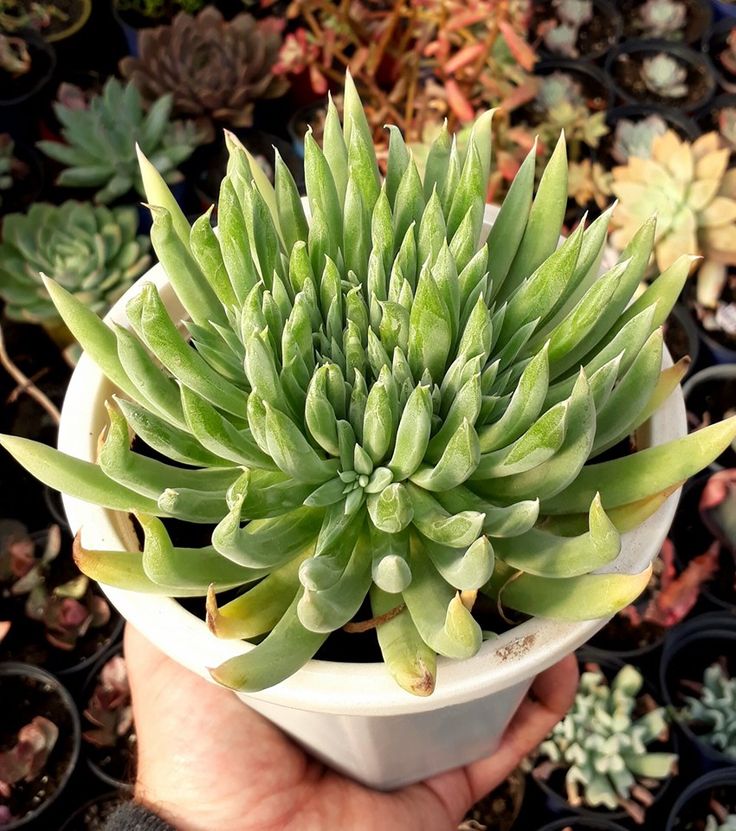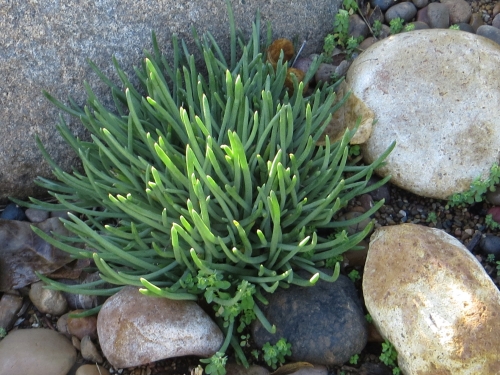Dudleya edulis

Dudleya edulis, commonly known as Tasty Liveforever, is an intriguing succulent plant native to the coastal regions of California and Baja California.
Recognized for its unique appearance, edible leaves, and habitat in rocky coastal environments, this species holds both ecological and cultural significance.
In this comprehensive article, we will delve into the botanical intricacies, habitat preferences and care guidelines for Dudleya edulis.
Botanical Description
Tasty Liveforever is characterized by its tight rosettes of fleshy, spoon-shaped leaves with distinctive white powdery coating.
The leaves are succulent and have a blue-green to gray-green coloration, sometimes tinged with shades of pink or red, especially during periods of stress or drought.
The rosettes grow close to the ground and may form dense clusters in suitable conditions. In late spring to early summer, Dudleya edulis produces tall, slender stems adorned with clusters of small, star-shaped flowers in shades of white, pink, or yellow.
These flowers attract various pollinators, including bees, butterflies, and hummingbirds, contributing to the plant's ecological role.
Habitat and Distribution
Tasty Liveforever is native to coastal habitats, along the Pacific coast of California and Baja California.
It thrives in well-drained, rocky soils with good air circulation and abundant sunlight. Dudleya edulis is often found growing in association with other coastal plants, such as coastal sage scrub and chaparral species.
Its distribution ranges from the Channel Islands of California to the northern coast of Baja California, where it plays a crucial role in coastal ecosystems.
Life Cycle and Phenology
As a perennial succulent, Dudleya edulis follows a straightforward life cycle influenced by seasonal changes in temperature and moisture.
New rosettes emerge from the base of the plant in late winter to early spring, triggered by longer daylight hours and warming temperatures.
Flowering typically occurs from late spring to early summer, with peak bloom periods varying depending on local climate conditions.
After flowering, the plant may produce offsets or "pups" at the base, allowing it to spread and form colonies over time.
Tasty Liveforever is well-adapted to the Mediterranean climate of coastal California, exhibiting a period of summer dormancy to conserve water during dry periods.
Ecological and Cultural Importance
Tasty Liveforever plays a vital ecological role as a habitat provider and soil stabilizer in coastal environments.
The dense rosettes provide shelter and nesting sites for small animals and insects, while the flowers attract pollinators, contributing to the diversity of coastal ecosystems.
Additionally, Dudleya edulis has cultural significance as a food source and medicinal plant among indigenous peoples of California and Baja California.
The succulent leaves are edible and have been traditionally used in salads, soups, and other culinary preparations.
Furthermore, Tasty Liveforever has captured the interest of horticulturists, succulent enthusiasts, and gardeners for its ornamental value and adaptability to drought-tolerant landscapes.

Caring for Dudleya edulis
Sunlight
Plant Tasty Liveforever in a location that receives full sun or partial shade. It requires abundant sunlight to thrive and develop its characteristic dust coat.
Watering
Provide moderate water during the growing season, allowing the soil to dry out slightly between waterings to prevent root rot.
Avoid overwatering, especially during the plant's summer dormancy period.
Soil
Plant in well-drained, sandy or rocky soil with a neutral to slightly acidic pH.
Dudleya edulis prefers soil with good drainage and air circulation.
Mulching
Apply a thin layer of gravel or pebbles around the base of the plant to help retain moisture and suppress weeds.
Avoid covering the leaves with mulch, as this can trap moisture and lead to fungal diseases.
Pruning
Prune dead or damaged leaves as needed to maintain the health and appearance of the plant.
Remove spent flower stalks after flowering to encourage new growth and prevent self-seeding.
Following these care guidelines allows cultivation of healthy Dudleya edulis plants, aiding conservation efforts for this iconic species and coastal biodiversity.
Whether in pots, rock gardens, or coastal landscapes, Tasty Liveforever enchants with beauty and cultural significance.
Leave a Reply
You must be logged in to post a comment.